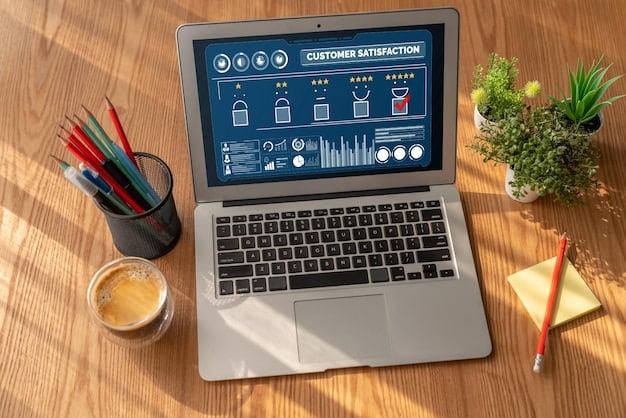E-commerce Marketing Automation: Invest for 20% ROI

E-commerce marketing automation platforms offer tools like personalized email campaigns, targeted ads, and customer segmentation, potentially delivering a 20% ROI through enhanced customer engagement and streamlined marketing efforts, making them a valuable investment.
In today’s competitive e-commerce landscape, businesses are constantly seeking strategies to enhance customer engagement and drive revenue. Investing in e-commerce marketing automation platforms can be a game-changer, potentially unlocking a 20% ROI through streamlined processes and personalized customer experiences.
Understanding E-commerce Marketing Automation
E-commerce marketing automation involves leveraging software and technology to automate repetitive marketing tasks, personalize customer interactions, and optimize marketing campaigns. This allows businesses to enhance efficiency, improve customer experience, and ultimately drive sales growth.
By automating tasks such as email marketing, social media posting, and customer segmentation, e-commerce businesses can free up valuable time and resources to focus on strategic initiatives and innovation.
Key Components of E-commerce Marketing Automation
Effective e-commerce marketing automation relies on several key components working together seamlessly. These include data collection and analysis, customer segmentation, personalized content creation, and automated campaign execution.
Benefits of Automating E-commerce Marketing
The benefits of implementing e-commerce marketing automation are numerous. Businesses can achieve increased efficiency, improved customer retention, personalized customer experiences, and enhanced ROI through effective use of these tools.
- Increased Efficiency: Automate repetitive tasks to save time and resources.
- Improved Customer Retention: Personalize interactions and build lasting relationships.
- Enhanced ROI: Optimize campaigns and drive sales growth.
In conclusion, understanding the core principles and benefits of e-commerce marketing automation is crucial for businesses looking to thrive in today’s digital marketplace. By investing in the right platforms and strategies, companies can unlock significant growth opportunities and achieve a 20% ROI.
Identifying the Right Automation Platform
Selecting the right e-commerce marketing automation platform is critical for achieving a 20% ROI. The ideal platform should align with your business objectives, integrate seamlessly with your existing systems, and offer the features and capabilities you need to engage customers effectively.
Before making a decision, it’s essential to assess your specific requirements, consider your budget, and evaluate the scalability and flexibility of different platforms.

Factors to Consider When Choosing a Platform
Several factors should be considered when selecting an e-commerce marketing automation platform. These include ease of use, integration capabilities, pricing structure, customer support, and security features.
Popular E-commerce Marketing Automation Platforms
There are numerous e-commerce marketing automation platforms available in the market, each with its strengths and weaknesses. Some of the most popular platforms include HubSpot, Mailchimp, Klaviyo, and ActiveCampaign.
- HubSpot: Offers a comprehensive suite of marketing, sales, and service tools.
- Mailchimp: Ideal for email marketing and campaign automation.
- Klaviyo: Specializes in e-commerce email marketing and segmentation.
- ActiveCampaign: Provides powerful automation and CRM capabilities.
Ultimately, the right platform will depend on your specific needs and priorities. Taking the time to research and compare different options can help you make an informed decision that sets you up for success.
Implementing Personalized Email Marketing Campaigns
Personalized email marketing campaigns are a cornerstone of e-commerce marketing automation. By tailoring email content to individual customer preferences and behaviors, businesses can significantly increase engagement, drive conversions, and cultivate brand loyalty.
Effective email personalization involves leveraging customer data, creating targeted segments, and crafting compelling messages that resonate with each recipient.
Creating Targeted Customer Segments
The key to successful email personalization is to create targeted customer segments based on demographics, purchase history, browsing behavior, and other relevant data points. This allows you to deliver highly relevant content to each segment.
Crafting Compelling and Personalized Email Content
Once you have your segments defined, it’s time to create compelling and personalized email content that speaks directly to the needs and interests of each recipient. Use dynamic content, personalized greetings, and product recommendations to enhance engagement.

- Use Dynamic Content: Tailor email content based on customer data.
- Personalized Greetings: Address recipients by name for a personal touch.
- Product Recommendations: Suggest relevant products based on past purchases.
In summary, personalized email marketing campaigns are an essential component of e-commerce marketing automation. By investing in the right tools and strategies, businesses can significantly improve customer engagement and drive revenue growth.
Leveraging Data Analytics for Campaign Optimization
Data analytics play a crucial role in optimizing e-commerce marketing automation campaigns. By tracking key metrics and analyzing campaign performance, businesses can identify areas for improvement and refine their strategies for maximum impact.
Effective data analytics involves setting clear goals, tracking relevant metrics, and using insights to make informed decisions about campaign optimization.
Key Metrics to Track for E-commerce Marketing Automation
Several key metrics should be tracked to assess the effectiveness of e-commerce marketing automation campaigns. These include email open rates, click-through rates, conversion rates, and customer lifetime value.
Using A/B Testing to Improve Campaign Performance
A/B testing is a powerful technique for improving campaign performance. By testing different versions of your emails, landing pages, and ads, you can identify which elements resonate most with your audience and optimize your campaigns accordingly.
Data analytics are essential for optimizing e-commerce marketing automation campaigns and achieving a 20% ROI. By tracking key metrics, analyzing campaign performance, and using A/B testing, businesses can refine their strategies for maximum impact.
Integrating Social Media with Marketing Automation
Integrating social media with marketing automation can significantly amplify your reach, enhance customer engagement, and drive traffic to your e-commerce store. By automating social media posting, running targeted ad campaigns, and monitoring social sentiment, businesses can create a cohesive and effective marketing strategy.
Effective social media integration involves aligning your social media activities with your overall marketing goals, using automation tools to streamline your efforts, and engaging with your audience authentically.
Automating Social Media Posting
Social media automation tools can help you schedule posts, curate content, and engage with your audience more efficiently. This allows you to maintain a consistent presence on social media without manually posting every update.
Running Targeted Social Media Ad Campaigns
Social media platforms offer powerful targeting capabilities that allow you to reach specific demographics, interests, and behaviors. By running targeted ad campaigns, you can increase brand awareness, drive traffic to your e-commerce store, and generate leads.
- Schedule Posts: Maintain a consistent presence on social media.
- Curate Content: Share relevant and engaging content with your audience.
- Run Targeted Ads: Reach specific demographics and interests.
In conclusion, integrating social media with marketing automation can significantly enhance your reach, engagement, and ROI. By leveraging automation tools, running targeted ad campaigns, and engaging with your audience authentically, you can create a powerful and effective marketing strategy.
Measuring ROI and Optimizing for Long-Term Success
Measuring ROI is essential for evaluating the effectiveness of your e-commerce marketing automation efforts and optimizing your strategies for long-term success. By tracking key performance indicators (KPIs) and analyzing campaign results, businesses can identify what’s working and what’s not, and make data-driven decisions to improve their ROI.
Effective ROI measurement involves setting clear goals, tracking relevant metrics, and using insights to refine your campaigns continuously.
Setting Clear Goals and KPIs
Before you can measure ROI, you need to set clear goals and KPIs that align with your business objectives. These might include increasing sales, improving customer retention, or generating more leads.
Analyzing Campaign Results and Making Adjustments
Once you have your goals and KPIs defined, it’s time to analyze your campaign results and make adjustments as needed. Identify what’s working well and what’s not, and make data-driven decisions to improve your ROI continuously.
Measuring ROI and optimizing for long-term success are critical components of e-commerce marketing automation. By setting clear goals, tracking relevant metrics, and analyzing campaign results, businesses can refine their strategies and achieve a 20% ROI.
| Key Point | Brief Description |
|---|---|
| 🚀 Automation Benefits | Increases efficiency and improves customer retention. |
| 🎯 Platform Selection | Choose based on business needs and budget. |
| 📧 Personalized Emails | Tailor content to boost engagement and loyalty. |
| 📊 Data Analytics | Track metrics to optimize campaign performance. |
FAQ
E-commerce marketing automation uses software to automate repetitive marketing tasks, personalize customer interactions, and streamline campaigns. This increases efficiency and drives sales growth by tailoring the customer experience.
Consider your business needs, budget, integration capabilities, and scalability when selecting a platform. Popular choices include HubSpot, Mailchimp, and Klaviyo. Research and compare options to make an informed decision
Personalized email campaigns increase engagement, drive conversions, and build loyalty by tailoring content to individual customer preferences. Use data to segment customers and deliver relevant messages.
Data analytics tracks key metrics like open and click-through rates. A/B testing refines emails and ads. These measures enable continuous optimization for better campaign results by identifying successful strategies.
Integrating social media amplifies reach and drives traffic through automation. Scheduling posts and running targeted ads creates cohesive marketing. Authentic engagement with your audience boosts overall brand.
Conclusion
Investing in e-commerce marketing automation platforms can be a strategic move for businesses looking to enhance customer engagement and drive revenue growth. By understanding the key components of automation, selecting the right platform, and implementing personalized campaigns, companies can unlock significant ROI and achieve long-term success in today’s competitive digital marketplace.





